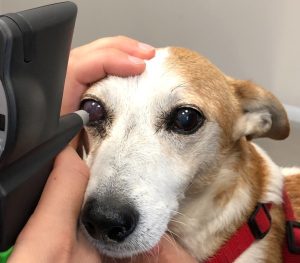In glaucoma, every hour that passes reduces the chances of successful therapy.
So if your dog or cat presents one of the clinical signs listed in our article'Opaque eye could be glaucoma'the first thing to do is to have him examined immediately (or as soon as possible) by a vet, preferably an ophthalmologist.
Diagnosis of glaucoma
 The instrument needed to measure intraocular pressure, the electronic tonometer (either a magnetic rebound or applanation tonometer), is generally not present in basic veterinary facilities, which is why a specialist ophthalmological examination is recommended. A complete ophthalmological examination will not only allow a diagnosis to be made, but also an assessment of the prognosis. In some cases it may be necessary to carry out special investigations, such as the gonioscopy or theocular ultrasound.
The instrument needed to measure intraocular pressure, the electronic tonometer (either a magnetic rebound or applanation tonometer), is generally not present in basic veterinary facilities, which is why a specialist ophthalmological examination is recommended. A complete ophthalmological examination will not only allow a diagnosis to be made, but also an assessment of the prognosis. In some cases it may be necessary to carry out special investigations, such as the gonioscopy or theocular ultrasound.
The gonioscopy consists of using a special lens that, when applied to the cornea, allows the iridocorneal angle - the area through which aqueous humour drains - to be visualised. It is mainly performed in cases where primary glaucoma is suspected, based on clinical history and race. Generally, only local anaesthesia is sufficient, so that the gonioscopy lens can be placed on the cornea without bothering the patient too much.
Ocular ultrasound can be useful in cases where the eye is already opaque and the intraocular structures cannot be visualised. Even in this case, local anaesthesia is usually sufficient to allow the probe to be placed directly on the cornea or eyelids held closed.
Unfortunately, glaucoma is an irreversible disease, unless the underlying cause can be removed, such as in the case of dislocation of the crystalline lens, where the lens can be surgically removed. This means that medical therapy will have to be adopted for the rest of the patient's life.
Therapy generally consists of a combination of medication (mostly eye drops) and regular check-ups at the veterinary ophthalmologist.
In selected cases, a surgical approach is also available. Unfortunately, despite therapeutic efforts, it is often difficult to keep glaucoma under control and medical therapy may no longer be effective within a variable timeframe.
If the pressure is permanently high despite therapy, intraocular pain is also considerable, and in the case of blindness, enucleation is the best indication for treating chronic pain.
Therapy
The treatment of glaucoma can be medical, surgical or associated. Medical therapy is undoubtedly the first approach and must be immediate. The main aim is to lower the intraocular pressure to levels that the eye can tolerate, treat the underlying cause (if it exists and is possible), reduce the risk of blindness as much as possible, trying to preserve as much vision as possible and, last but not least, control pain.
Therapy must always be set up under the direct and strict control of the veterinary doctor, and do-it-yourself therapies and advice from 'who knows why his dog/cat too...' should be absolutely avoided. Each individual is a separate case and must be followed by the doctor.
 The medical therapy mainly consists of the administration of eye drops that reduce the production of aqueous humour or increase its drainage via the unconventional route.
The medical therapy mainly consists of the administration of eye drops that reduce the production of aqueous humour or increase its drainage via the unconventional route.
- Osmotic diuretics. Mannitol is used ONLY in emergencies in the treatment of acute glaucoma. It is administered intravenously and requires specialist attention.
- Synthetic prostaglandin analogues. They increase drainage through the unconventional route, and are therefore generally quite effective. Administered once or twice a day, Latanoprost, Travoprost and the like can be used on a long-term basis.
- Carbonic anhydrase inhibitors. They reduce aqueous humour production, thus reducing intraocular pressure. These include Dorzolamine and Brinzolamide. Oral drugs do not show superior efficacy and are a potential cause of systemic side effects.
- β-blockers. By reducing blood flow to the ciliary bodies, they reduce the production of aqueous humour. Not are among the most widely used in veterinary ophthalmology, but may have synergistic effects with other topical therapies. Especially in small animals they may have side effects, particularly if concomitant pulmonary or cardiac diseases are present. These include Timolol and Betaxolol.
We look forward to the third instalment to consider cases where medical therapy fails to bring the condition under control.
We will see together what is best to do and how best to manage our sick animal.
Daniele Santillo
Dr. Daniele Santillo
Med Vet, CertVOphthal, MRCVS
RCVS Advanced Practitioner in Veterinary Ophthalmology
Arezzo - Santillo short CV
In this section:
- Focus on: veterinary ophthalmology
- The opaque eye: not only cataracts...
- Opaque eye: could be glaucoma?
- Glaucoma: when medical therapy does not work...

